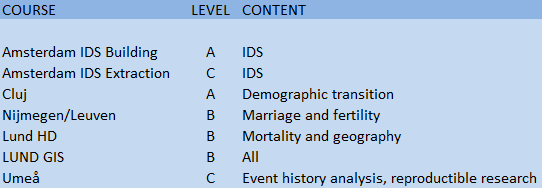One of the objectives of EHPS-Net is to organise summer and winter schools in the field of historical demography, both for young students, who have graduated at least a master’s program in social sciences, and for advanced researchers who already have a research agenda and need to improve their technical and methodological skills in the field. There is a need for the historical demography in all countries to permanently recruit young scientists who want to specialise in the history and methodology of this science, who want to develop this science, and want to elaborate new scientific paradigms. At the same time, for Ph.D. students in social sciences, it is highly important to attend historical demography courses to widen their theoretical training, and to be trained in an interdisciplinary manner.
There are currently seven different courses organised in the EHPS-Net programme: Two are at basic level, one on theoretical aspects of database design and the Intermediate Data Structure (IDS) in Amsterdam and one in Cluj in historical demography. There are three more advanced courses, focusing on theoretical and practical aspects of historical demography, in Lund (HD), Lund (GIS) and Nijmegen/Leuven. Finally, there are two advanced courses: in Amsterdam (IDS extraction) and Umeå (demography and event history analysis).


CLUJ-NAPOCA – HISTORICAL DEMOGRAPHY INTRODUCTORY COURSE
The course is organized by Babes-Bolyai University and EHPS-Net and it is specially designated to all those interested to develop a research in historical demography – PhD students, young researches, post-doctoral researchears Basic level, theoretical aspect. Yearly – first edition 2013.
Aim:
General understanding of basic demographic/population processes in historical change and in a global view.
Target:
PhD students, post-doctoral researches, young researches focused on historical demography and/or family history.
Prerequisites:
A good knowledge of English.
A research subject in historical demography.
Basic knowledge in statistics and dealing with numbers.

LUND – HISTORICAL DEMOGRAPHY
The course provides theoretical training and a complete hands-on approach to working in historical demography: designing research questions, and creating datasets to test research hypotheses. The course makes students familiar with the Scanian Economic Demographic Database (SEDD) and IDS.
Prerequisites:
Knowledge of demographic and quantitative methods.
Applicants should either be enrolled in an MSc or PhD program or have recently received their PhD.

LUND GIS - ADDING THE GEOGRAPHIC CONTEXT TO DEMOGRAPHIC ANALYSIS
This course provides methods and theories for linking longitudinal historical demographic records to maps. It makes students familiar with standard methods in GIS and the Scanian Economic Demographic Database (SEDD).
Prerequisites:
Knowledge of demographic and quantitative methods.
Applicants should either be enrolled in an MSc or PhD program or have recently received their PhD.
![]()
HISTORICAL DEMOGRAPHY: RECONSTRUCTING LIFE COURSE DYNAMICS
This course is specifically aimed at teaching young MA and PhD students complicated database management techniques of longitudinal life course data and introducing them to important analytical tools such as occupational coding systems and geographical analysis techniques. This 9-day course is characterized by two important features. First of all, the course will offer a theoretical introduction into the life course approach, its central concepts, and to a limited number of substantial themes which can be usefully studied in this way. The second and major component of the course consists of a thorough training in the skills required to handle dynamic life course data from large historical databases, starting from the raw data contained in data entry files right up to the point at which the data are ready to be analyzed by complex statistical analysis such as event history analysis. These skills will be taught by using Microsoft Access, R Studio, and the Historical Sample of the Netherlands (HSN).
Prerequisites:
Basic computer skills; sufficient English language proficiency
![]()
DEMOGRAPHY AND EVENT HISTORY ANALYSIS USING R
This advanced course is organized by the European Historical Population Samples Network (EHPS-Net), the Graduate School in Population Dynamics and Public Policy (GSPDPP), and the Center of Demographic and Aging Research (CEDAR). It revolves around event history and survival analysis in a demographic context, utilising individual continuous-type data describing life histories; or register data, where individuals are observed in principle once a year. The course will provide an introduction to reproducible research.
Software to be used: R, RStudio.
Prerequisites:
Knowledge of basic demographic and statistical methods.
Applicants should either be enrolled in an MSc or PhD program or have recently received their PhD.
Applicants must have a research agenda where the analysis of life course data is essential, and where taking this course would be of substantial importance.
A working knowledge of the English language is essential, because all teaching activities, including written material, are given in English.
![]()
AMSTERDAM – WORKING WITH IDS AND EXTRACTION SOFTWARE
The course has two goals. The first one is to teach researchers how to structure the historical sources they want to explore. This will be done by introducing two methods of data structuring: Entity Relationship Design and Normalization. After a theoretical introduction students will do information analysis on their own historical sources. By discussing the results students will learn what the best solutions are in structuring their historical sources.
![]()
AMSTERDAM – DATABASE DESIGN AND THE INTERMEDIATE DATA STRUCTURE
Point of departure of the course are the existing databases that have restructured their data into the format of the Intermediate Data Structure (IDS). Main goal is to teach about the way existing extraction software can be used to make datasets for analysis. The second goal is to use (parts of) the software to make new datasets for analysis and/or develop new designs of software to construct datasets for analysis.
